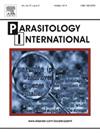Blastocystis in humans and domestic animals: Risk factors assessment and potential zoonotic transmission in a periurban and rural region of Northeastern Argentina
IF 1.9
4区 医学
Q3 PARASITOLOGY
引用次数: 0
Abstract
Blastocystis is a protist that infects both human and animal hosts worldwide. This study aimed to investigate the presence of Blastocystis in humans and domestic animals living in a periurban (PZ) and rural zone (RZ) in Northeastern Argentina and to assess their relation to socio-environmental conditions and hygiene practices as risk factors for human infection. In addition, we identified Blastocystis subtypes to evaluate the risk of zoonotic transmission. A total of 563 fecal specimens were collected from 289 humans, principally children, and 274 animals. Samples were examined by coprological examination and further analysis by real-time PCR and sequencing were performed. A semi-structured questionnaire was applied to obtain socio-environmental and hygiene practices data. The results showed an overall prevalence of 41.6 % in children and 10.2 % in animals. Non-schooled children (OR = 0.54) and children from urban area (OR = 0.55) showed a lower risk of infection. Molecular analyses revealed five subtypes (ST1, ST2, ST3, ST5, and ST7) present in humans and four subtypes (ST1, ST5, ST7 and ST10) in animals. The overlap of STs between humans and domestic animals in the same household (STs 1, 5 and 7) suggests potential zoonotic transmission, underscoring the role of infected animals as a potential risk factor for human infections. Our results can inform local health authorities to promote policies aimed at reducing transmission, emphasizing the need for direct molecular-level assessments of other common environmental sources, such as water and soil, highlighting the importance of adopting a One Health approach to better understand Blastocystis circulation.
人与家畜囊虫病:阿根廷东北部城郊和农村地区的危险因素评估和潜在的人畜共患传播
囊虫是一种在世界范围内感染人类和动物宿主的原生生物。本研究旨在调查居住在阿根廷东北部城市周边地区(PZ)和农村地区(RZ)的人和家畜中囊虫的存在,并评估其与社会环境条件和卫生习惯作为人类感染危险因素的关系。此外,我们鉴定了囊虫亚型,以评估人畜共患传播的风险。共收集了289人(主要是儿童)和274只动物的563份粪便标本。标本经coprology检查,real-time PCR和测序进一步分析。采用半结构化问卷获取社会环境和卫生习惯数据。结果显示,儿童和动物的总患病率分别为41.6 %和10. %。非学龄期儿童(OR = 0.54)和城区儿童(OR = 0.55)感染风险较低。分子分析显示,人类存在5种亚型(ST1、ST2、ST3、ST5和ST7),动物存在4种亚型(ST1、ST5、ST7和ST10)。同一家庭中人类和家畜之间的STs重叠(STs 1、5和7)表明可能存在人畜共患传播,强调受感染动物作为人类感染的潜在风险因素的作用。我们的研究结果可以为地方卫生当局提供信息,以促进旨在减少传播的政策,强调需要对水和土壤等其他常见环境来源进行直接的分子水平评估,强调采用“同一个健康”方法以更好地了解囊胚循环的重要性。
本文章由计算机程序翻译,如有差异,请以英文原文为准。
求助全文
约1分钟内获得全文
求助全文
来源期刊

Parasitology International
医学-寄生虫学
CiteScore
4.00
自引率
10.50%
发文量
140
审稿时长
61 days
期刊介绍:
Parasitology International provides a medium for rapid, carefully reviewed publications in the field of human and animal parasitology. Original papers, rapid communications, and original case reports from all geographical areas and covering all parasitological disciplines, including structure, immunology, cell biology, biochemistry, molecular biology, and systematics, may be submitted. Reviews on recent developments are invited regularly, but suggestions in this respect are welcome. Letters to the Editor commenting on any aspect of the Journal are also welcome.
 求助内容:
求助内容: 应助结果提醒方式:
应助结果提醒方式:


